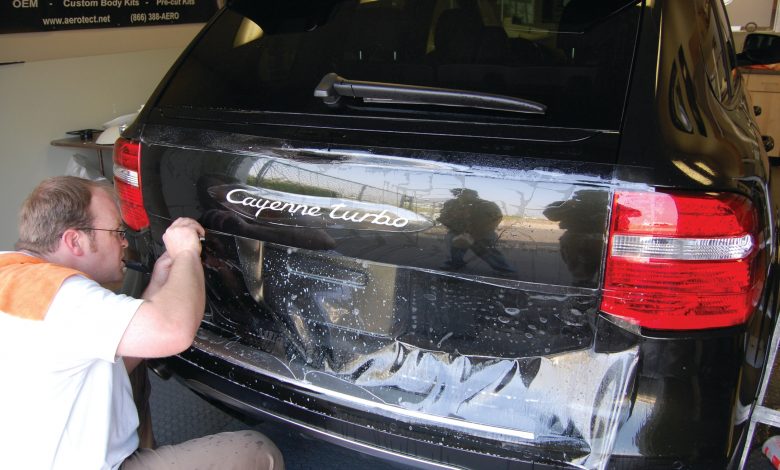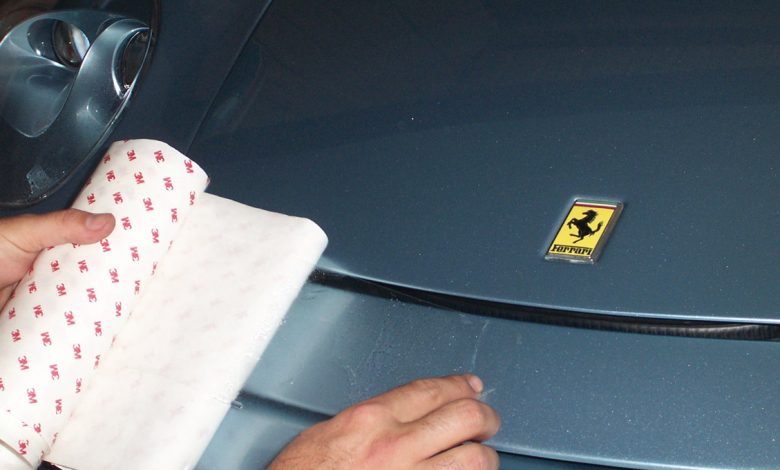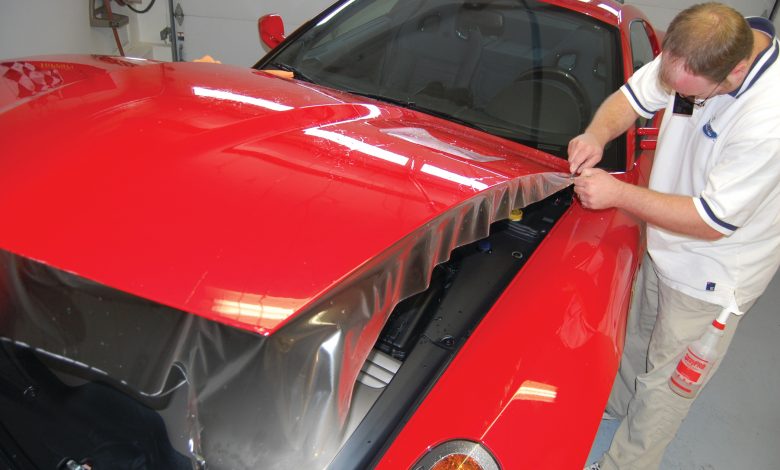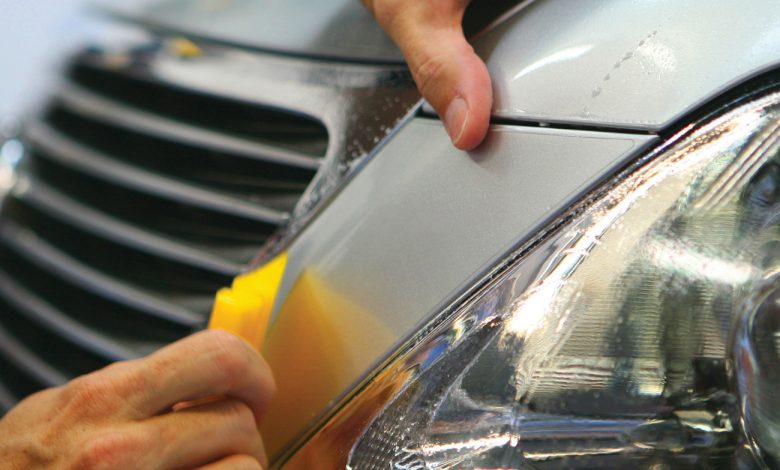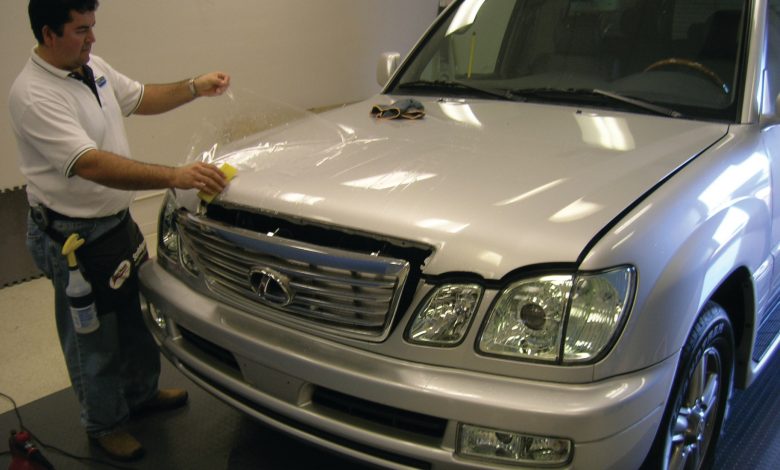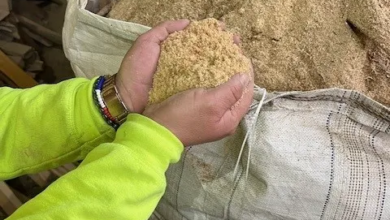Flawless PPF Installation
From start to finish, this is how to get the most out of your paint protection film application.
Applying paint protection film (PPF) from start to completion takes much preparation. Like a graphics vehicle wrap, the vehicle must be pristinely prepped and cleaned, but in many ways, the application techniques are different. However, if you are already doing wrap work for dealerships, this could be an attractive additional service to offer. Let’s look at what goes into a PPF wrap.
Preparing For Application
Before starting the PPF installation, it is important to open the lines of communication with the client. When details go unaddressed, particularly when it comes to specifications, the customer might feel his or her expectations were not met, according to Francisco Castillo, president of AeroTect, a bulk film and pre-cut kit distributor in La Verne, Calif. Simply taking a few minutes to discuss the exact process of the installation can save a lot of potential headaches, he says.
“Sometimes the customer just drops off the car and leaves, and then you install an 18-inch pre-cut kit, while the customer thought he was getting a 24-inch pre-cut kit,” Castillo says. “It’s important you’re open to telling the customer what the specs of the kit will be, so you end up with a happy customer.”
Castillo also recommends examining the car with the client before the installation. Any previous chips or dents should be noted along with any aftermarket paint.
When trying to resell a car, dealers often paint the surface without a primer, resulting in paint that can easily peel off during a PPF installation. Not only does this make for an unhappy customer, but it also costs the wrap shop a new paint job. Once the car has been examined, be sure to have the client sign a liability form that outlines the vehicle’s condition.
Next, the shop should record the proper year, make and model of the install vehicle. This step is vital in the case that a customer, for instance, thinks the vehicle is an EX when it’s really a DX, resulting in major differences in body style, according to Jamie Werner, business trainer of Premium Shield, a manufacturer of surface protection film in Holliston, Mass. The make, model and year can be confirmed by plugging the VIN number into a simple Internet search.
“Not having the right information can cost more money because you might have already cut the kit, and it’s the wrong kit,” Werner says. “You end up having to purchase another kit or cut another kit, so it’s very important that you get all the information on the car, and you’re aware of what you’re installing.”
Vehicle Prep
Before application, the vehicle and the installation area should be thoroughly cleaned, says Mike Sasala, outside sales representative of Performance Tools Distributing, a distributor of PPF supplies in Plain City, Ohio. In fact, Sasala considers this the most important step.
If any dust or dirt is on the vehicle, it will become trapped and show underneath the film. Sasala recommends washing the vehicle and removing unwanted particles by running a clay bar over all of the surface areas set to be wrapped. Then, the installer should use compressed air to blow dry any cracks or areas that hold dirt or other kinds of contamination.
“You’ll want to spend more time with an older vehicle that’s been on the road. It’s been exposed to the elements a little bit longer,” Sasala says. “If the paint is not smooth, you might need to buff it at a very minimum for any car. Even with brand-new cars, you’ll have to wash to get off all contaminants.”
Additional supplies to use include a squeegee, vinyl cutter, blade and protection strip.
“Be sure that your vinyl cutter is in optimal condition,” says Daniel Valade, product manager of Roland DGA Corp., a digital printing products provider in Irvine, Calif. “Be sure your blade is in good working condition, free of any chipping and that it is not dull. The cutter protection strip that runs along the cut path should not have any visible damage and should be flush with the groove where it is installed. These three maintenance tips will help to ensure quality cuts when trimming up your paint protection film.”
Wet Installation
The main difference in installation techniques between graphic or paint-wrap film installation and PPF installation is the fact that PPF installers overwhelmingly use the wet installation technique. Once the vehicle is clean, the installation process starts by peeling the backing off the film and slowly beginning to unroll it across the installation area.
While rolling, the installer should spray the surface area with a soap solution. This allows the installer to maneuver the film while it’s being placed in proper position. A tack solution is also used to improve a film’s adhesion.
When using the slip and tack solutions, measuring your own mix can have a major impact, says Todd Bergman, PPF installer at Interwest, a 3M PPF training facility in Denver.
If the ratios are off, the solutions will not properly do their jobs, he says. Bergman recommends a tack solution with 8 ounces of 70 percent isopropyl alcohol for every 32 ounces of water. When the concentration of alcohol is higher, it needs to be adjusted to reach a ratio of 25 percent alcohol and 75 percent water.
To create a slip solution, Bergman measures his soap in fractional cups and adds it to water to ensure its consistency.
“Your idea of a drop size may be different than mine,” Bergman says. “When solutions are off, it can increase the installation time as you’re fighting when you need to tack and slide.”
Once the PPF installation is complete, the shop should make sure it communicates care instructions with the customer, Werner says. The average consumer does not wash his or her vehicle often, which can impact the longevity of the PPF. Certain care should be taken with PPF, but consumers can’t properly maintain their vehicles’ new PPF without the information upfront.
“I highly recommend treating the film with a synthetic wax every 30 to 60 days and using a protective layer of wax to keep the luster,” Werner says. “Let customers know that they don’t have to be afraid to wash it.”
Post-Application
While the PPF application may be complete, the job isn’t necessarily done. A successful PPF installation means having a happy customer. A job well done creates the perfect opportunity to leverage future marketing efforts, especially with today’s digital platforms, Werner says.
Of course, every shop should have a website and Facebook page where customers can see not only vehicle before and after shots, but also the application progress.
“You want to actually show the process of installation so people can see what this is about,” Werner says. “I’ve seen several success stories of people taking video, and consumers find it really intriguing to watch. Then, they end up inquiring about PPF for their vehicles.”
Online car forums represent another avenue for digital marketing, Sasala says. Despite being car buffs, many forum visitors are not familiar with PPF applications, giving a shop the chance to educate potential customers on the process. However, a shop should be careful in how it refers to PPF on a forum. Car dealerships typically try to sell customers on an expensive paint protection chemical, which is often mistaken for PPF.
“A clear bra is always a good term to use because it doesn’t sound like it’s going to be a chemical application,” Sasala says. “A lot of people have seen those black bras in the past, so they’re familiar with that term. I want to be able to engage the customer right from the very beginning and explain to them exactly what the product is and what it does.”
Properly preparing for PPF application leads to completing a perfect installation job. The marketing opportunities that result can go a long way toward enhancing your existing customer base.

